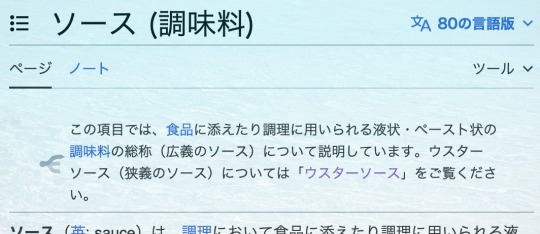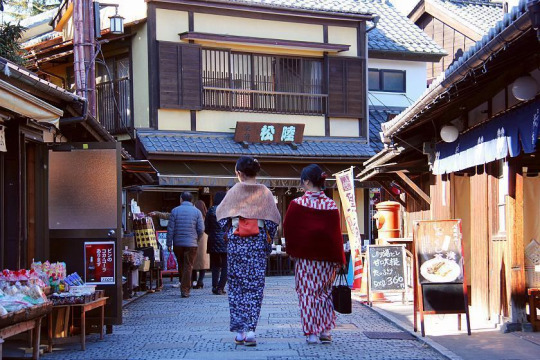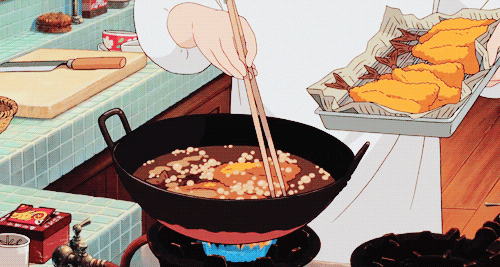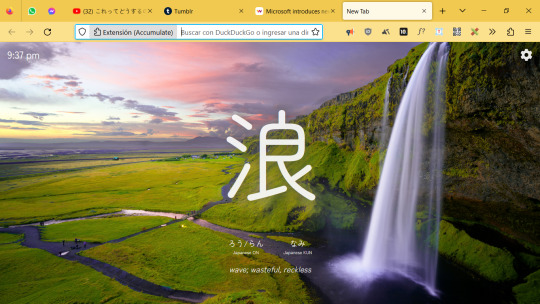Dani | located in Europe, Germany | she/her | ace-aro | 34 Studying Business Administration and some Japanese to hopefully manage N2 some year. Maybe next. I reblog stuff I think is aestethic or useful.
Don't wanna be here? Send us removal request.
Text
Found a new language practice app!
Polygloss has you describe an image in your target language so another player can guess it. It encourages creative answers. The game works for people of all levels — you can describe simple pictures or try your hand at wordplay.

It has plenty of options and will let you add any language you’d like — tho it’ll probably be more difficult to find people to play with.
1K notes
·
View notes
Text

なるほど。。。
*looks at the camera like im on the office*
201 notes
·
View notes
Text
How to start reading books in Japanese
This is a great blog on how to start reading books in Japanese. Even if you already read in Japanese, it has some interesting things to think about in the way you approach Japanese books.
479 notes
·
View notes
Text
[Japanese→English] @panmaumau Tweet — Color Coded Translation

————————————————————————
何も知らない生き物の顔
なにもしらないいきもののかお
The face of a living thing that doesn’t know anything.
————————————————————————
Please correct me if I made a mistake
333 notes
·
View notes
Text
罠英語・Trap Words pt 5
ソース → ❌ Sauce → ✅ Japanese style worchestershire sauce

In Japanese common usage, the word 「ソース」 only refers to a specific subcategory of sauce - japanese style worchestershire sauces. Although in certain technical circumstances, 「ソース」 may also carry the broader meaning that the english equivalent does, calling something like soy sauce 「ソース」 in a regular conversation won’t get your meaning across.¹
We can see this in the Japanese Wikipedia article for ソース. Though the article is about the broader definition of sauce, there is a notice at the top of the page:

“This article is about the general name for a liquid or paste used to season food (the broad definition of 「ソース」). For Worchestershire Sauce (the narrow definition of 「ソース」), see Worchestershire Sauce.”² (my translation)
Side note: I know it's a meme but "Worchestershire" isn't hard to say. It's just "wooster-sheer".
Though ソース can be found as a part of various other words ( ミートソース/meat sauce; ホワイトソース/white sauce; トマトソース/tomato (pasta) sauce), when it is used just by itself, it almost exclusively refers to worchestershire sauce varieties. For example, you can’t abbreviate ミートソース to ソース, even when the context is clear.
Within the category of what Japanese speakers mean when they say ソース, we have ウスターソース, which is similar to the thin English Worchestershire sauce; 濃厚ソース, which is sometimes marketed as tonkatsu sauce and is very thick and viscous; and 中濃ソース which is somewhere in between. お好み焼きソース is also a type of ソース, similar to 濃厚ソース.³
グリーンピース → ❌ Greenpeace → ✅ peas
Yep… the word グリーンピース doesn’t refer to the environmental activism organisation Greenpeace, which I discovered to some surprise during an actual conversation with my Japanese partner. Since Greenpeace is famous for its anti-whaling stance, and Japan is the country with the highest levels of whaling in the world,⁴ it was only natural to assume that it was a direct transliteration of the organisation’s name. Maybe it’s a common point of discussion in Japan, I thought.
In reality, it literally just means peas. Green peas. An instance of the plural being built into the transliteration (like バケツ), since Japan has no plurals. It’s weird that it’s not グリーンピーズ though, don’t you think? I guess we can just chalk that up to an initial pronunciation error that carried though to the modern day.⁵
Why hasn’t it been shortened to ピース? Well:

Because ピース means “the peace sign”. This word/pose is so common in Japanese culture that shortening グリーンピース to ピース would likely be confusing.
To be clear, the organisation’s name is also transliterated as グリーンピース, but overwhelmingly in regular conversation, グリーンピース will mean “peas”.
トレーナー → ❌ trainers (sneakers) → ✅ sweatshirt
This might not necessarily be a trap word for people from the US, but it is at least a funny place for 和製英語 to show up. According to this source, this word was invented by a fashion designer named Kensuke Ijizu, who was apparently a big boxing fan, and noticed that the trainers always wore sweatshirts, and so decided to name the clothing 「トレーナー」 when he released his designs in Japan⁶. It’s rare that a trap word has such a clear explanation for how it came about! めっちゃスッキリした!
However, スウェット and スウェットシャツ are also both commonly used in Japanese, meaning the same as トレーナー, so this is really only a problem while listening, not while speaking.⁷ It’s also worth noting that トレーナー does mean “trainer” as in like, a personal trainer. That’s where the weird word for sweatshirt comes from, after all.
Sources
[1] https://www.youtube.com/watch?v=OLpub5uXA1A
[2] https://ja.wikipedia.org/wiki/ソース_(調味料)
[3] https://www.kurashiru.com/articles/b3134417-fc0e-4782-a5d8-40932613ea79
[4] https://www.abc.net.au/news/2014-04-08/whaling-around-the-world-how-japans-catch-compares/5361954
[5] https://twitter.com/japanese_eng/status/1562198000411193345
[6] https://zatsuneta.com/archives/007218.html
[7] https://ja.wikipedia.org/wiki/スウェット
57 notes
·
View notes
Text
埼玉県
Japanese Prefectures: Kantō - Saitama
都道府県 (とどうふけん) - Prefectures of Japan
Learning the kanji and a little bit about each of Japan’s 47 prefectures!
Kanji・漢字
埼 さき、さい、みさき、キ cape, spit, promontory
玉 たま、~だま、ギョク jewel, jade; ball
県 ケン prefecture
関東 かんとう Kanto, region consisting of Tokyo and surrounding prefectures
Prefectural Capital (県庁所在地) : Saitama City (さいたま市)

Saitama is Tokyo's neighbor to the north. Much of southeastern Saitama is considered a suburb of Tokyo, but the western parts are mostly rural with mountainous forested areas, and include a castle town and the Chichibu-Tama-Kai National Park. Saitama has historically been a fertile agricultural region and is currently the major food supplier for the metropolitan area of Greater Tokyo. Some of the first currency in Japan came from copper discovered in the Chichibu area in the 8th century. Saitama's central location has made it a historical hub for transportation to all parts of Eastern Japan, and the modern radial roads and railroad system are designed for ease of transportation to all parts of Japan. Saitama is also the backdrop to the famous Miyazaki Hayao (Studio Ghibli) film "My Neighbor Totoro."
Recommended Tourist Spot・おすすめ観光スポット Kawagoe - 川越

Kawagoe
The Edo-period castle town of Kawagoe is also known as Ko-edo (小江戸 or "Little Edo") because of its many traditional buildings dating from the Edo period. The streets have been maintained as-is since the Edo period (1603-1867). The weekends are the most popular times for visitors to gather here and experience the atmosphere, shops, and popular seasonal events. In the third week of October, the Kawagoe Festival is held with a parade of traditional ornate floats and a musical competition.
The Warehouse District is lined with old earthen storehouses, which are unique two-story buildings that have remained unchanged since the days when the city was a major transportation and commerce hub for Eastern Japan. The Toki no Kane, or "Bell of Time," has marked time for the town for centuries, and continues to ring four times daily. Candy Street is a street lined with stores where traditional Japanese sweets are made in the old-fashioned way.
For more recent history, the Taisho-Roman Street has old, retro western-style buildings from the Taisho and Showa areas. There are also no overhead power lines, which makes this a popular spot to shoot many Japanese period films set in these eras.
There are severable notable temples and shrines in Kawagoe, especially Kitain Temple, which was built over 1,000 years ago. This temple has 538 stone statues of Buddha, each with its own face and unique posture. No two statues look alike, and the popular belief is that there is a statue to resemble any visitor to the temple. Kawagoe Hikawa-jinja Shrine is a Shinto shrine dating back to the 6th century that boasts a torii shrine gate that is 15 metres tall. Kawagoe Kumano-jinja Shrine has fortunes, lucky charms, and also boasts the "stepping health road," which is a path to walk barefoot to stimulate the acupuncture points on the soles of your feet for health benefits.
Regional Cuisine - 郷土料理 Miso Potato - 味噌ポテト

Miso Potato (source)
Famous in the Chichibu region of Saitama, miso potatoes are a well-known winter treat in the area. This dish is similar to a baked potato covered in sweet miso sauce and is traditionally from the rural areas in the mountainous part of the prefecture. It is now a popular street stall snack that combines the sweet and savoury miso flavours with the earthy baked potato texture.
Saitama Dialect・Saitama-ben・埼玉弁
1. むじっけー mujikkee cute
むじっけー猫だね。 (mujikkee neko da ne)
Standard Japanese: かわいい猫だね。 (kawaii neko da ne)
English: What a cute cat.
2. ああみぃ aahmii no good, can't do it (also, ああみ, aahmi)
ごめん、明日ああみぃ。 (gomen, ashita aahmii)
Standard Japanese: ごめん、明日行けない。 (gomen, ashita ikenai) or ごめん、明日はダメ。 (gomen, ashita wa dame)
English: Sorry, I can't go tomorrow. or Sorry, tomorrow is no good.
3. かみぎっちょ gamigiccho lizard
庭のすみっこにかまぎっちょがいたで。 (niwa no sumikko ni kamagiccho ga itade)
Standard Japanese: 庭の隅にとかげがいたよ。 (niwa no sumi ni tokage ga ita yo)
English: There was a lizard in the corner of the garden.
4. うちゃる ucharu to throw away
そこにうちゃるなよ。 (soko ni ucharu na yo)
Standard Japanese: そこに捨てるなよ。 (soko ni suteru na yo)
English: Don't throw that away there.
5. こわい ~kowai hard
このおせんべいこわい。 (kono osenbei kowai)
Standard Japanese: このおせんべい硬い。 (kono senbei katai)
English: This senbei is hard.
*Note: senbei is a Japanese rice cracker
6. えらい erai a lot
今日はえらい食べるな。 (kyou wa erai taberu na)
Standard Japanese: 今日はたくさん食べるな。 (kyou wa takusan taberu na)
English: Don't eat a lot today.
63 notes
·
View notes
Text
With the current promotion on Bookwalker Japan you can again read some first volumes of well-known manga series for free. If you are interested in getting a taste of reading manga in Japanese without committing to a purchase right away, I can really recommend it. You don't need to create an account - all you have to do is click on the red button with 無料で読む and get started. Just note that these offers all expire at the end of January!
暗殺教室. Assassination classroom. Read the first 3 volumes for free: https://bookwalker.jp/de1ae0ece7-a723-4183-a3c8-42209f36b107/
ゴールデンカムイ. Golden Kamuy. Read the first 10 volumes for free: https://bookwalker.jp/de6ecf59e4-aedd-49a0-85af-e8c2821c0ccd/
斉木楠雄のΨ難. The Disastrous Life of Saiki K. Read the first 3 volumes for free: https://bookwalker.jp/debf655d7f-320d-4273-a0e1-acc570192a72/
古見さんは、コミュ症です。Komi Can't Communicate. Read the first 5 volumes for free: https://bookwalker.jp/de77cc1af7-42e0-4f41-80a1-e662093d0084/
葬送のフリーレン. Frieren. Read the first 2 volumes for free: https://bookwalker.jp/dedbb6f380-b665-45c4-8e5c-f4a191fa2a75/
171 notes
·
View notes
Note
hi! i'm sorry for the dumb question but i wanted to finally start reading manga in japanese (i already have a little list of titles beginner-friendly) buuuut i'm not sure where i actually find it ;; sorry again for the stupid question
Not a dumb question at all! There are a bunch of places to get manga, the most accessible probably being (unfortunately) amazon.jp. You need to have a Japanese address to buy things regardless of where it's being shipped to (or not, in the case of ebooks), but I believe just any address will do. You can also sometimes buy manga directly on the publisher's sites. Cmoa is another good place to check, and they also will often have entire volumes of manga available to read on their site for free (just look for the 無料 section). Bilingualmanga might also be of interest. It's free (and therefore sometimes gets taken down), but is exactly what it sounds like. Their selection isn't huge, but what they do have, they have in both English and Japanese.
If you want to buy physical volumes, CDJapan is my go-to. I'm in the USA, but I'm pretty sure they ship to most parts of the world. Kinokuniya is also a good place to buy manga from, especially if you're lucky enough to have a physical store near you. My main issue with them is that I think they're overpriced, though. Another thing that depends on luck, if you have any Book Off stores near you, go check them out! It's secondhand, so finding what you're looking for is definitely luck based, but I think it's a good experience to browse Japanese language books and manga regardless.
If you're having trouble finding something in particular, or want some... slightly less legal sources, feel free to contact me off anon!
47 notes
·
View notes
Text

day 13 ❤️
there was a diy afternoon dedicated to the candles
268 notes
·
View notes
Text
ive just had the greatest galaxy brain moment of my life i just need to animate it real quick
936 notes
·
View notes
Text


I just realized that the kanji for bone, 「骨」, looks like a little skeleton fella, and I can't get over it...
50K notes
·
View notes
Text
後味
あとあじ
aftertaste
言い争いをして後味の悪い思い出が残った。 いいあらそい を して あとあじ の わるい おもいで が のこった。 The quarrel left an unpleasant aftertaste.

50 notes
·
View notes
Text
I have something I want to check, but the answer may scare me. Alright, here it goes:
Please reblog, though I'm pretty sure it's gonna be pretty conclusive regardless of sample size.
32K notes
·
View notes
Text
Assortment of random Japanese words I‘ve learned since arriving here without studying
足元(あしもと)- at one’s feet, underfoot (heard over a tannoy announcement at the station warning passengers to take care when boarding the train)
参る(まいる)- to come, to go (humble) (they never say “電車がきます” when the train’s arriving; it’s always “電車が参ります”)
まもなく - soon (humble) (again, they never say “もうすぐ” on the train; it’s always まもなく. To the point where I actually forget もうすぐ and end up saying まもなく to my teacher and she laughs at me)
最高の(さいこうの)- the best (from My Hero Academia, because they say “the best hero” literally all the time, and at first I was like “you want to be a psycho hero? What??”)
残念(ざんねん)- unfortunate, too bad (randomly heard on the radio and recalled I’d looked it up recently, and then heard it again a couple of times in anime)
さすが - as expected of (hear it in My Hero Academia aaaaall the time)
揚げ鶏(あげどり)- Japanese-style fried chicken (I asked the cashier how to pronounce it when I ordered it)
本線(ほんせん)- mainline (I hear this literally every time I use the local trains because it’s the name of the line, but I only just figured out what it means)
鼻水(はなみず)- snot (lit. nose water) (hear this all the time when kids want a tissue. They just come up to me and say “先生。鼻水” and I’m like ok gross just go get a tissue you don’t have to ask me)
おっぱい - boobs (heard in class as I got groped by a five-year-old girl, double-checked the meaning on the way home)
甲虫(かぶとむし)- rhinoceros beetle (they’re on one of the videos we put on for the kids when they’re coming into the class and they all just say “kabutomushi” whenever it comes up on screen)
かぶと - a particular style of traditional Japanese helmet worn by ancient warriors (it’s in one of the pictures I had to use this term where I ask the kids “what can you see?” and every single class someone would point to it saying “kabuto”)

I was actually really confused the first time they said it because Kabuto is the name of a Pokemon (and not one I’d really expect them to know because it’s from the original 150 and hasn’t really featured in more recent generations) but it looks like this:

So I was like. Wtf there’s no Kabuto here, wtf are you on about?
137 notes
·
View notes
Text
Daily Foodstuffs in Japanese

食品 しょくひん food, food products, foodstuffs
佐藤 さとう sugar
塩 しお salt
食塩 しょくえん table salt
しょう油 しょうゆ soy sauce
油 あぶら oil
てんぷら油 てんぷらあぶら tempura oil
サラダ油 サラダあぶら cooking oil (lit. salad oil)
緑茶 りょくちゃ green tea
紅茶 こうちゃ tea (black tea)
315 notes
·
View notes
Text
I think I found the Japanese equivalent to Comic Sans.
So I've always had trouble reading Japanese on the default windows font, because it was made for a much different kind of monitor where it doesn't look shit. After stealing some shady code off the internet and searching for hours for the perfect font, I chose Zen Kurenaido. It's one of those fonts that roud up everything so there's no sharp edges. I chose it thinking it would cause the same effect as san serif fonts do in the Latin alphabet.
Serif fonts, like this, are ideal for print, because they add sharp edges that do not smudge as easily, meaning it's easier to read. On your display, however, it looks busy and tires the eye, which is why in digital we usually use sans serif, which is rounder and easier to process.
My idea was that I would be able to read Japanese faster if I got rid of the edges and abstracted the characters to their base shape.
It works. However, there is a catch.
It looks godawful.

It looks condescending. It's like it's looking down to me. Moreover, it reminds me of this:

There is absolutely nothing wrong with the font, it is objectively very good. It just doesn't feel right. And the problem is, it actually does what I wanted it to do. I can absolutely read Japanese faster and more comfortably now. It is improving my life, it is helping me so much. It just looks so damn goofy.

I can't even respect my kanji of the day extension anymore. It looks like a street sign you hang at the airport so the foreign tourists don't feel intimidated by the language.
But man, subtitles are on easy mode now.

I can actually catch up with the auto captions now. I've never been able to do that before, I just assumed my kanji knowledge was bad, but no, it was just the damn edges making it hard to read. And now I have to live with the fact that this goofy ass font is objectively the best way to read Japanese digitally. I can't ever change it back. I made this hell for myself.
494 notes
·
View notes
Text

三月 ・ デザート
March - Desserts
マフィン ・ muffin
カップケーキ ・ cupcake
クッキー ・ cookie
ソフトクリーム ・ soft serve ice cream
ケーキ ・ cake
プリン ・ (custard) pudding
パイ ・ pie
ゼリー ・ jelly
クレープ ・ crepe
夏の時期、清涼なコーヒーゼリーは特に美味しいです。日本ではコンビニで買えますが、デンマークでは自分で作らなきゃ食べられません。それでは、こちらがシンプルなレシピ!
71 notes
·
View notes